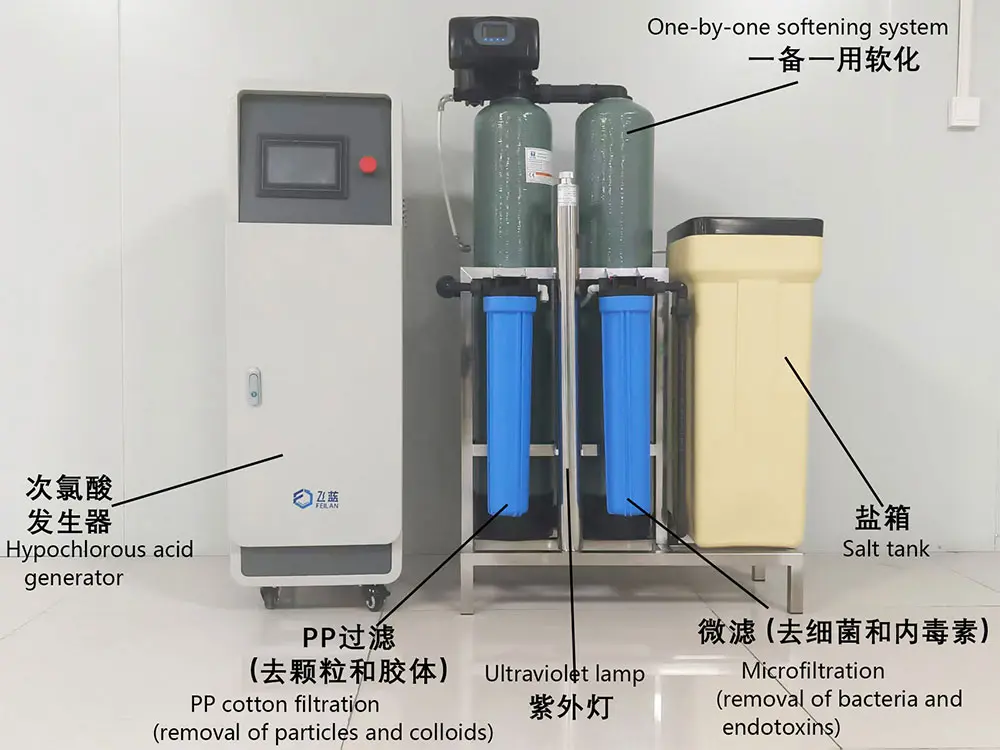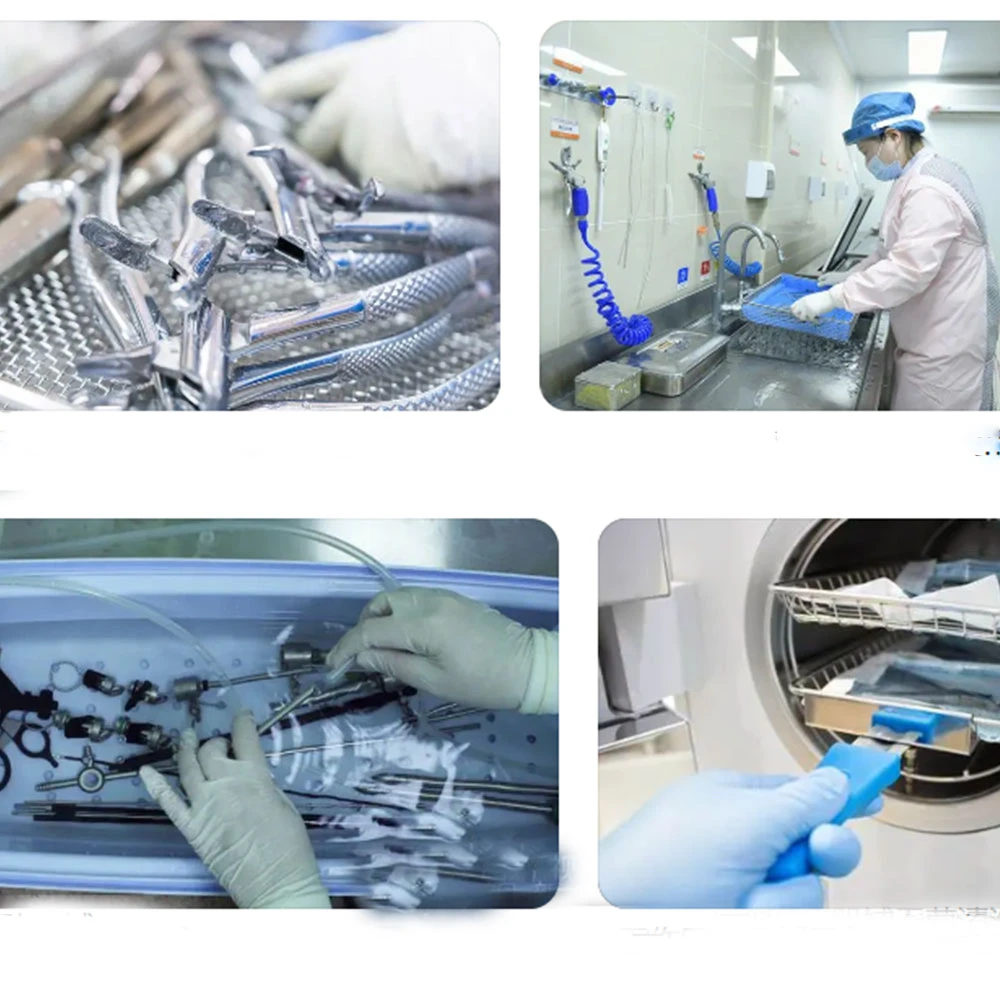Due to In the field of oral medicine, ensuring the hygiene and safety of the treatment environment is of vital importance. Therefore The oral comprehensive treatment table, as the core equipment for dentists to diagnose and treat. The cleanliness of its waterway system is directly related to the health of patients and medical staff. Hypochlorous acid generators,.As an efficient and safe disinfection device, are gradually emerging in the application of comprehensive oral treatment tables.

Contamination risks of the comprehensive oral treatment table
Due to The waterway of the dental comprehensive treatment table (DUWL) is composed of narrow and slender pipes. Therefore And this structure is highly susceptible to bacterial contamination. Bacteria colonize in the pipes and form biofilms. During the treatment process, these colonies can enter the patient’s mouth with water flow or
be inhale into the respiratory tract by the patient and dental staff through aerosols produced by ultrasonic scaling machines and
high-speed turbine mobile phones, thereby causing infections. According to relevant research,
the bacterial content in the waterways of dental comprehensive treatment tables that have not been effectively disinfected may reach several thousand
or even tens of thousands of CFU (colony-forming units) per milliliter of water. The contamination of waterways in dental
comprehensive treatment tables has become one of the important ways of cross-infection in dentistry.
The working principle of hypochlorous acid generator
A micro-acidic hypochlorous acid generator refers to a device that adds an appropriate amount of sodium chloride solution and/or hydrochloric acid solution to a diaphragm electrolytic cell or a membrane-free electrolytic cell. Through electrolysis, chloride ions lose electrons on the anode side to generate chlorine gas. The chlorine gas reacts with water to produce hypochlorous acid and hydrochloric acid, thereby obtaining micro-acidic hypochlorous acid with hypochlorous acid as the main bactericidal component and a PH value of 5.0 to 6.5. The electrolytic reaction equation is as follows:
Cl- → 1/2Cl2+e-
Cl2 + H2O = HClO + H+ + Cl-
H+ + e- → 1/2H2
The application scenarios of hypochlorous acid generators in oral comprehensive treatment tables
1. Waterway disinfection: From the water supply pipeline to the internal pipelines of the comprehensive diagnosis and treatment desk. Hypochlorous acid water is continuously used for disinfection. Because hypochlorous acid water can continuously act on the waterway system, it makes it difficult for the bacteria.Viruses and other infection sources sucked back by handheld machines to breed in the waterway. Eliminating blood-borne cross-infection from the root. Whether it is the continuous water supply during daily diagnosis and treatment or the regular flushing and disinfection of waterways during breaks, the hypochlorous acid water produced by the hypochlorous acid generator can ensure the cleanliness of the waterways.
2. Instrument cleaning and disinfection: All kinds of instruments used in the treatment process. Such as dental drills, tweezers, probes, etc., must be thoroughly treated before and after use. Soaking the instruments in hypochlorous acid water for cleaning can not only easily remove surface stains and residues, but also kill bacteria, fungi.Viruses and other microorganisms attached to the instruments by virtue of the strong oxidizing property of hypochlorous acid. Ensuring the hygiene and safety of the instruments for the next use.
3. Oral treatment assistance: During periodontal scaling and teeth cleaning, hypochlorous acid water is poured into the water storage tank, which can effectively remove the periodontal biofilm, and at the same time play a role in sterilization, anti-inflammation.And anti-infection, reduce the immune response.Relieve the patient’s pain and reduce bleeding. In dental implant surgery. The use of hypochlorous acid water can reduce the risk of intraoperative bleeding and infection.Relieve postoperative pain and swelling.Promote wound healing.And prevent the occurrence of peri-implantitis. During root canal treatment, hypochlorous acid water can rinse out the residual pulp and tooth debris tissue, kill bacteria and reduce inflammation. Reduce bleeding, relieve pain, prevent and remove the smear layer. And reduce the postoperative apical reaction. For conditions such as fistulas, sinus tracts, and apical abscesses.Hypochlorous acid water can flush out purulent substances within the lesion, promoting wound healing
4. Disinfection of the treatment room environment: Hypochlorous acid disinfectant can be widely used for comprehensive disinfection of the treatment room floor and surface disinfection of various objects such as tables and chairs. Regular disinfection of these areas can effectively reduce the transmission routes and opportunities of bacteria and viruses. During the diagnosis and treatment process.Aerosols formed by droplets and splashes produced by patients are suspended in the air.Posing a significant risk of cross-infection. Hypochlorous acid disinfectant can effectively eliminate common bacteria and fungi in the air and decompose odors. Ensuring the cleanliness and safety of the indoor space environment and creating a healthy and comfortable environment for doctors, nurses and patients.

The advantages of applying hypochlorous acid generators to comprehensive oral treatment tables
1,remarkable bactericidal effect: The bactericidal effect of hypochlorous acid is much higher than that of
other chlorine-based disinfectants such as sodium hypochlorite. Its sterilization principle is unique.
Hypochlorous acid molecules (HClO) do not carry an electric charge and can easily penetrate the cell membrane
to undergo oxidation reactions with DNA and mitochondria within the cell. Under the same available chlorine conditions,
its sterilization ability is approximately 80 to 150 times that of hypochlorite ions (ClO -). It can kill various bacterial propagules.
Multiple viruses and spores in an extremely short time, such as Escherichia coli.Candida albicans, Bacillus subtilis var.
Niger spores and poliovirus, etc. The sterilization rate can reach 99.999%.
2. High safety: Hypochlorous acid disinfectant is non-toxic when administered orally or inhaled acutely.
And it does not irritate the eyes or oral mucosa. Long-term use by medical staff will not damage the skin on their hands or irritate the respiratory tract.
At the same time.It has a natural high compatibility with the human body. Even if it accidentally comes into contact
with oral tissues during oral treatment, it will not cause harm to the patient.
3. Mild and non-corrosive: Compared with some strongly corrosive disinfectants. Hypochlorous acid water is mild in nature.
Even if it is use for waterway disinfection in the oral comprehensive treatment table for a long time,
the corrosion to the dental chair pipeline is extremely slight.Which can effectively extend the service life of
the treatment table equipment and reduce the maintenance cost of the equipment.

FAQ
1,Can hypochlorous acid be used for gargling?
Low concentrations, such as 5-10PPM, can be use for gargling.
2,Is hypochlorous acid generator safe for oral use?
Hypochlorous acid is slightly acidic and harmless to the human body.
3,Can hypochlorous acid remove biofilms in pipelines?
Hypochlorous acid can kill the biofilm in the pipeline
